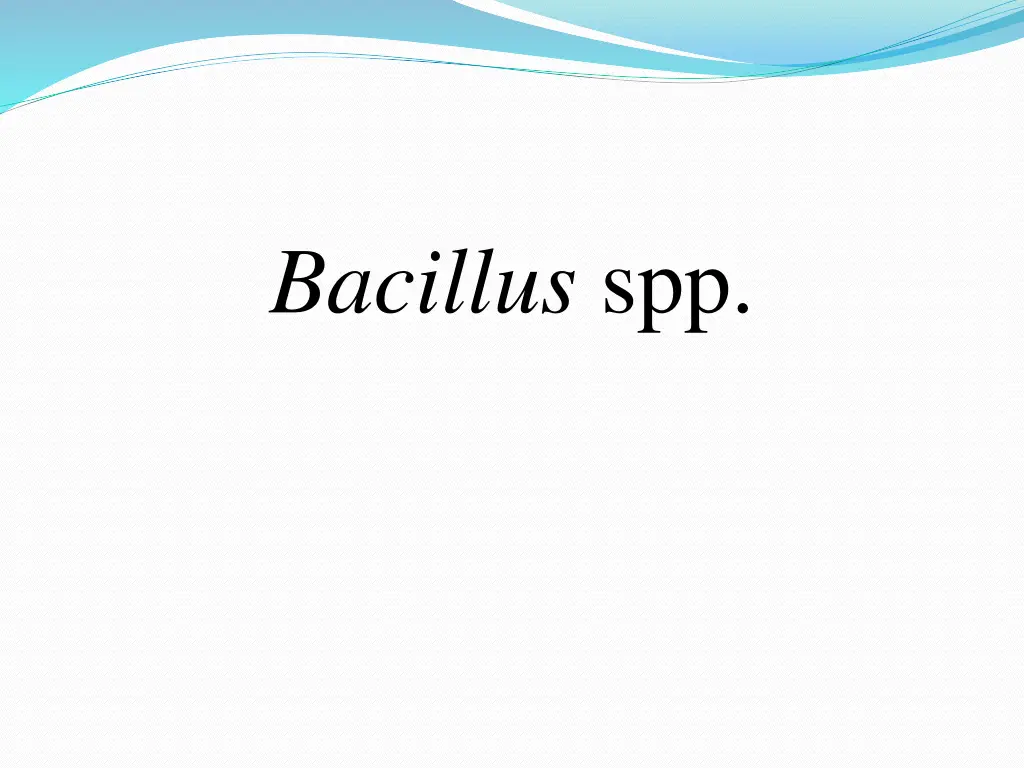
Characteristics and Diseases of Bacillus Species
"Learn about the general characteristics of Bacillus species, including their motility, gram staining properties, endospore formation, and culture characteristics. Explore the diseases associated with Bacillus, such as anthrax and food poisoning caused by B. cereus."
Download Presentation

Please find below an Image/Link to download the presentation.
The content on the website is provided AS IS for your information and personal use only. It may not be sold, licensed, or shared on other websites without obtaining consent from the author. If you encounter any issues during the download, it is possible that the publisher has removed the file from their server.
You are allowed to download the files provided on this website for personal or commercial use, subject to the condition that they are used lawfully. All files are the property of their respective owners.
The content on the website is provided AS IS for your information and personal use only. It may not be sold, licensed, or shared on other websites without obtaining consent from the author.
E N D
Presentation Transcript
General Characteristics of Bacillus Generally motile with peritrichous flagella except B. anthracis (non-motile) . Gram positive bacilli when young, but in some species become Gram negative as they age. Produce endospores: non-bulging, central oval spores. endospores of living bacilli appear edged in black and are very bright and refractile. Endospores strongly resist application of simple stains or dyes and hence appear as non- staining entities in Gram-stain preparations. Ends of bacilli are truncated or concave giving a Bamboo stick appearance (end to end arranged long chains of bacilli)
Peritrichous bacteria have flagella projecting in all directions Endospores
Culture Characteristics of Bacillus Colonies on blood agar are nonhemolytic, flat or slightly convex with irregular edges and ground-glass appearance. There are often comma shaped projections from the colony edge producing a Medusa-head colony. Gelatinase-positive : giving inverted fir tree appearance due to slow liquefaction of gelatin. Aerobic or facultative anaerobic Can flourish at extremes of acidity & alkalinity (pH 2 to 10)
Colonies on blood agar are nonhemolytic fir tree appearance
Diagnosis Swab from cutaneous lesion, Sputum, Fluid, pus. Gram Stained smears from the local lesion or of blood from dead animals often show chains of large gram-positive rods. Spores seen after several days of incubation, but not typically in fresh clinical specimens
Diseases Associated with Bacillus Most are Ubiquitous in nature, Bacillus includes both free-living (nonparasitic) species, and two parasitic pathogenic species. These two Bacillus species are medically significant: B.anthracis causes anthrax; and B. cereus causes food poisoning. Bacillus anthracis is most important member. Primarily a disease of herbivorous animals. Most commonly transmitted to humans (Accidental host) by direct contact with animal products (e.g., wool and hair) Also acquired via inhalation & ingestion B. cereus Infections: Cause food poisoning. infection include emetic (vomiting) and diarrheal forms of gastroenteritis.
Clinical Presentation of Anthrax Cutaneous Anthrax: 95% human cases are cutaneous infections. Small, pruritic, non-painful papule at inoculation site. Papule develops into hemorrhagic vesicle & ruptures. Slow-healing painless ulcer covered with black eschar surrounded by edema. Inhalation Anthrax: is the most deadly form, Virtually 100% fatal (pneumonic) Gastrointestinal (Ingestion) Anthrax: is a rare but commonly fatal disease.
Treatment & Prophylaxis Treatment Penicillin is drug of choice Doxycycline now commonly recognized as prophylactic Vaccine (controversial) Laboratory workers Employees of mills handling goat hair Active duty military members
citrate utilization test Citrate utlilization test is used to determine the ability of bacteria to utilize sodium citrate as its only carbon source. Procedure of citrate utilization test: Inoculate simmons citrate agar lightly on the slant by touching the tip of a needle to a colony that is 18 to 24 hours old. Incubate at 35oC to 37oC for 18 to 24 hours. Some organisms may require up to 7 days of incubation due to their limited rate of growth on citrate medium. Observe the development of color. + results: blue color - results: green color
